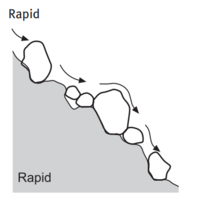Rapids
Версия от 00:16, 13 апреля 2024; Charmapatr (обсуждение | вклад)
Пороги – ступени продольного профиля реки на выступах, сложенных скальными породами[1].
Определение на английском
- Rapids are very stable, steep, stair-like sequences formed by arrangements of boulders in transverse ribs that partially or fully span the channel in bedrock-confined settings. (Пороги - очень устойчивые, крутосклонные формы рельефа ступенчатой формы, образованные поперечными грядами валунов, которые полностью или частично перекрывают русло реки в условиях стеснения русла устойчивыми коренными породами.)[3]
- Rapids are reach of a stream where the flow is very rapid and turbulent, and where the surface is usually broken by obstructions, but has no actual waterfall or cascade. (Участок реки с очень быстрым и бурным течением, на поверхности которого обычно выступают препятствия, но водопады или каскады отсутствуют.)[4]
Пример использования термина на английском языке
- In alluvial streams, riffles and pools are spaced according to discharge; since rapids in erosional streams may be analogous to riffles, rapids spacing may also be dependent on discharge.[5]
- The spacing of rapids has been attributed to intrinsic adjustment of sediment distribution toward maintaining a quasi-equilibrium longitudinal profile, to tributary debris fans that constrict the river at tributary mouths and reworking of the deposits by high discharges on the main stem.[6]
- Erosion of the debris-flow deposits and transport of the boulders through the rapid during different discharges was estimated with modeling.[7]
Перевод использования на русском языке
- В аллювиальных водотоках местоположение перекатов и плёсов определяется расходами воды; поскольку пороги в горных реках могут рассматриваться, как аналоги перекатов [в равнинных реках], расстояние между порогами также может зависеть от расходов воды.
- Расстояние между порогами определяется механизмом перераспределения наносов при выработке продольного профиля равновесия реки, наличием конусов выносов, которые сужают реку в устьях притоков, а также переработкой отложений за счет высоких расходов воды в основном русле.
- Эрозия [русел] селевыми потоками и транспорт валунов через пороги при различных расходах воды были оценены путём моделирования.
Список литературы
- ↑ Чалов Р.C., Русловые процессы (русловедение): учебное пособие, М., 2016. C. 565.
- ↑ Brierley G.J., Fryirs K.A. Geomorphology and River Management: Applications of the River Styles Framework. Geomorphol. River Manag. Appl. River Styles Framew. – 2008. https://doi.org/10.1002/9780470751367.
- ↑ Brierley G.J., Fryirs K.A. Geomorphology and River Management: Applications of the River Styles Framework. Geomorphol. River Manag. Appl. River Styles Framew. – 2008. https://doi.org/10.1002/9780470751367.
- ↑ WMO International Glossary of Hydrology. – 2012.
- ↑ Graf W.L. Rapids in canyon rivers. // Journal of Geology. – 1979. – Vol. 87. – № 5. https://doi.org/10.1086/628444.
- ↑ Webb R.H., Pringle P.T., Reneau S.L., Rink G.R. Monument Creek debris flow, 1984: Implications for formation of rapids on the Colorado River in Grand Canyon National Park // Geology. – 1988. – Vol. 16. – № 1. https://doi.org/10.1130/0091-7613(1988)016<0050:MCDFIF>2.3.CO;2.
- ↑ Hammack L., Wohl E. Debris-fan formation and rapid modification at Warm Springs Rapid, Yampa River, Colorado // Journal of Geology. – 1996. – Vol. 104. – № 6. https://doi.org/10.1086/629865.
